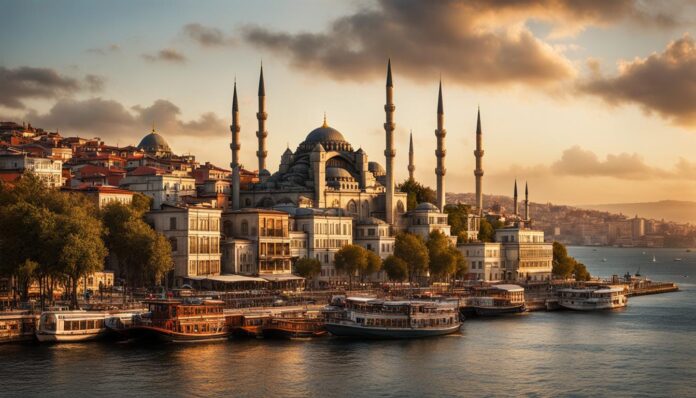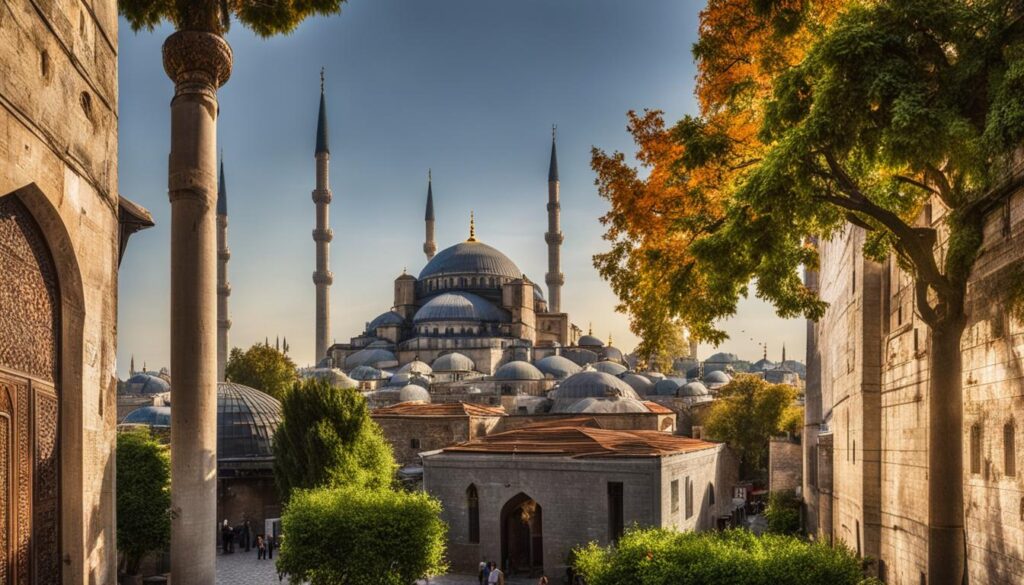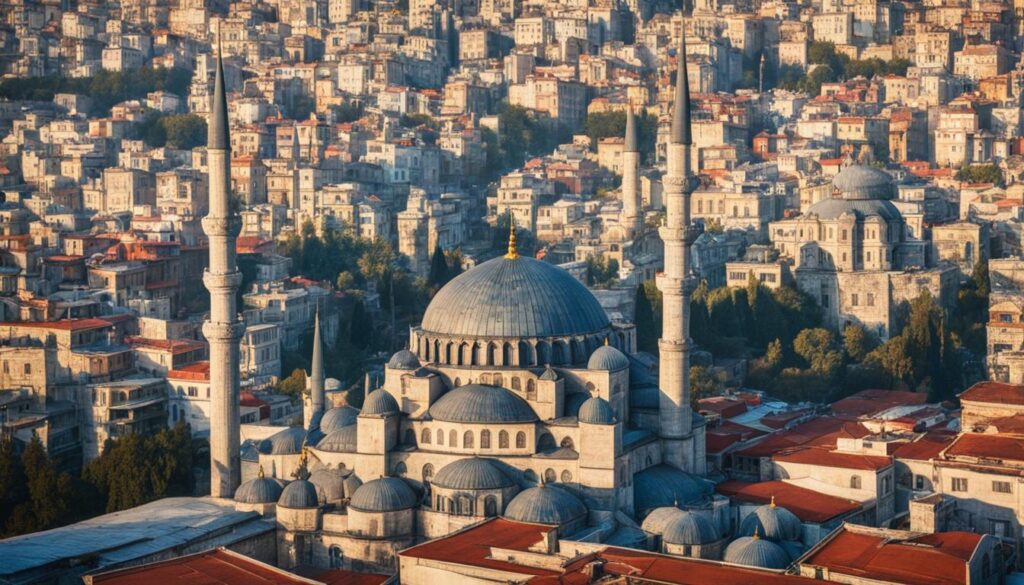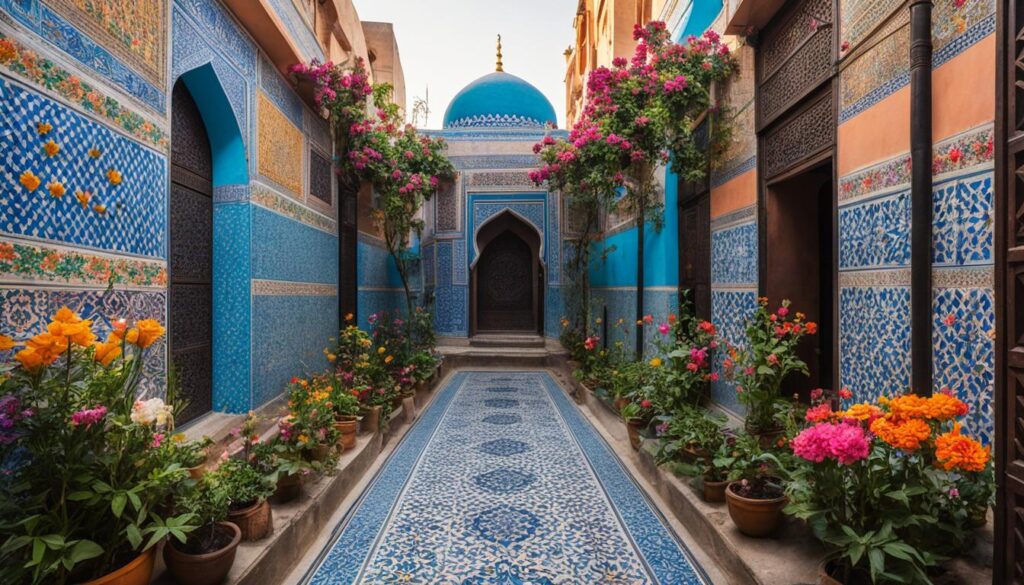If you are planning a trip to Istanbul, you have probably heard about the famous Blue Mosque. However, Istanbul’s religious heritage is much more than just this one iconic mosque. Beyond the Blue Mosque, Istanbul is home to several hidden mosques and sacred sites waiting to be explored.
These lesser-known spiritual havens offer a glimpse into the city’s rich and diverse religious history, which has been shaped by various religions over centuries. By uncovering the hidden mosques and sacred sites, you will gain a deeper understanding of Istanbul’s cultural significance and religious traditions.
If you are looking for a unique and off-the-beaten-path experience in Istanbul, exploring these hidden gems should be on your itinerary. Let’s dive in and discover the lesser-known mosques and religious sites that lie beyond the famous Blue Mosque.
Istanbul’s Rich Spiritual Heritage
Throughout history, Istanbul has been a crossroads of cultures and religions, shaping the city’s diverse spiritual heritage. The former capital of the Byzantine and Ottoman empires, Istanbul was home to different peoples who left their mark on the city’s religious history. From Christianity to Islam, Judaism to Greek Orthodox, Istanbul’s spiritual landscape is rich and varied.
Did you know that Istanbul has over 3,000 mosques and countless other religious sites, each with its unique story and significance? The city is filled with hidden gems waiting to be discovered, offering a glimpse into the spiritual traditions of Istanbul’s past and present.
Understanding Istanbul’s religious history is key to discovering the city’s hidden mosques and sacred sites. By learning about the different faiths that have shaped Istanbul’s past, you can gain a deeper appreciation for the unique charm and significance of each religious site.
The Religious Legacy of Istanbul’s Byzantine Empire
The Byzantine Empire played a crucial role in shaping Istanbul’s religious history. Iconic landmarks such as the Hagia Sophia and the Chora Church offer glimpses into Istanbul’s Byzantine past, with intricate mosaics and frescoes depicting Christian themes that reflect the city’s rich spiritual heritage.
The Ottoman Empire and the Rise of Islam in Istanbul
When the Ottoman Empire rose to power, Istanbul was transformed into the center of the Islamic world. The city’s mosques, including the Blue Mosque and Suleymaniye Mosque, are architectural marvels that symbolize Istanbul’s Islamic identity. The Ottoman Empire’s legacy can also be seen in Istanbul’s religious festivals and customs, such as the Ramadan fast and the celebration of Eid al-Fitr.
The Influence of Judaism and Greek Orthodox Christianity in Istanbul
Istanbul’s religious diversity extends beyond Islam and Christianity. The city is also home to vibrant Jewish and Greek Orthodox communities, each with their synagogues and churches. The Ashkenazi Synagogue and the Ecumenical Patriarchate of Constantinople are just a few examples of the lesser-known sacred sites that dot Istanbul’s landscape.
“Istanbul is the capital of the world” – Pierre Loti
As Pierre Loti aptly put it, Istanbul is truly the capital of the world when it comes to spiritual diversity. By exploring the city’s religious history and visiting hidden mosques and sacred sites, you can gain a deeper appreciation for Istanbul’s cultural and spiritual significance.
Uncovering Hidden Mosques in Istanbul
When it comes to Istanbul’s religious sites, the Blue Mosque is undoubtedly the most famous. However, the city is also home to many hidden mosques that offer a unique and authentic experience. These lesser-known places of worship are scattered throughout the city and often hidden from plain sight, making them all the more charming to discover.
Uncovering the hidden mosques of Istanbul is an exciting experience for anyone looking to explore the city’s spiritual diversity. Take a leisurely walk or join a guided tour to discover these secret gems, and be immersed in the city’s rich religious history.
These hidden mosques often have a distinct charm and serenity like no other, making them ideal for those seeking a peaceful escape from the hustle and bustle of the city. With their unique architecture and colorful interiors, each mosque has its own story to tell, providing visitors with a deeper understanding of Istanbul’s spiritual landscape.
Some of the popular hidden mosques in Istanbul include the Sokullu Mehmet Pasha Mosque, the Rüstem Pasha Mosque, and the Mihrimah Sultan Mosque. These lesser-known places of worship not only offer a peaceful retreat but also present an opportunity to experience authentic Istanbul like a local.
Hidden Mosques in Istanbul
| Mosque Name | Location | Architectural Style |
|---|---|---|
| Sokullu Mehmet Pasha Mosque | Üsküdar | Ottoman |
| Rüstem Pasha Mosque | Eminönü | Ottoman |
| Mihrimah Sultan Mosque | Edirnekapı | Ottoman |
| Güraba Hüseyin Ağa Mosque | Karagümrük | Ottoman |
| Kılıç Ali Pasha Mosque | Tophane | Ottoman Baroque |
| Ottoman Bank Museum | Karaköy | Ottoman Neo-Renaissance |
Uncovering the hidden mosques of Istanbul is an enriching experience that should not be missed. Take some time to explore the city’s religious sites beyond the Blue Mosque, and immerse yourself in its spiritual diversity.
Exploring Sacred Sites off the Beaten Path
While many visitors to Istanbul are familiar with its impressive mosques, the city is also home to a wealth of lesser-known sacred sites. These off-the-beaten-path religious sites offer a unique glimpse into the diverse spiritual landscape of Istanbul.
One such site is the Ahrida Synagogue, located in the Balat neighborhood. This historic synagogue dates back to the 15th century and continues to serve Istanbul’s Jewish community. Other sacred sites to visit include the Bulgarian St. Stephen Church and the Little Hagia Sophia Mosque, both of which offer stunning examples of Byzantine architecture.
To fully experience Istanbul’s spiritual diversity, consider taking a day trip to the nearby Iskender Pasha Mosque and Complex. This impressive complex, located in the district of Beykoz, includes a mosque, a madrasa, and a tomb.
Whether you’re interested in history, architecture or religion, Istanbul’s off-the-beaten-path religious sites offer plenty to discover. Venture beyond the well-known mosques and explore the spiritual diversity that makes this city so captivating.
The Charm of Istanbul’s Secret Mosques
While Istanbul is home to many famous mosques such as the Blue Mosque and the Hagia Sophia, the city also boasts a myriad of secret mosques waiting to be discovered. These hidden places of worship offer visitors a chance to experience the city’s spiritual traditions in a unique way.
The secret mosques in Istanbul are not just places of worship; they are also architectural marvels. From intricate tilework to soaring domes, these charming mosques showcase the city’s rich cultural heritage.
One such mosque is the Kılıç Ali Paşa Mosque, a 16th-century Ottoman mosque located in the Tophane district. This stunning mosque is known for its intricate marble carvings and striking blue tiles, creating a serene and tranquil atmosphere for visitors.
Another charming mosque worth visiting is the Şehzade Mosque, near the Süleymaniye Mosque. Built in the 16th century, this mosque is considered a masterpiece of Ottoman architecture, with intricate decorations and a peaceful atmosphere.
Visiting Istanbul’s secret mosques is not only a chance to admire the city’s architectural beauty, but also a unique way to gain a deeper understanding of the city’s religious traditions. These hidden gems offer visitors a glimpse into Istanbul’s spiritual diversity and provide a tranquil escape from the bustling city.
“Istanbul’s secret mosques are like hidden treasures waiting to be discovered. Each one tells a unique story and offers a chance for reflection and contemplation.”
Beyond the Blue Mosque: Unearthing Hidden Gems
While the Blue Mosque is undoubtedly iconic, there are many lesser-known hidden gems to discover in Istanbul. These hidden gems are the best way to experience the local culture, history, and architecture of Istanbul.
If you want to go beyond the Blue Mosque and unearth the city’s hidden treasures, plan a visit to neighborhoods such as Eyüp, Balat, and Fener. These areas are full of tucked-away neighborhood mosques, historic religious sites, colorful houses, and quaint restaurants that offer a glimpse into Istanbul’s local life.
To make the most of your trip, consider visiting some of the following hidden gems:
| Name | Description |
|---|---|
| Süleymaniye Mosque | One of the largest and most impressive mosques in Istanbul, located on a hill with an incredible view of the city. |
| Chora Church | Originally a Byzantine church, this is now a museum known for its amazing mosaics and frescoes. |
| Molla Zeyrek Mosque | A beautiful mosque with stunning architecture and intricate decoration, built in the 12th century. |
Other hidden gems worth visiting include the Kariye Museum, Galata Tower, and Yıldız Palace. Each of these destinations allows you to experience Istanbul’s unique charm and history.
Uncovering these secret mosques and sacred sites is a great opportunity to get an authentic and meaningful travel experience in Istanbul. Don’t hesitate to go beyond the Blue Mosque and discover the hidden gems waiting to be explored.
A Journey through Istanbul’s Spiritual Landscape
Embark on a journey through Istanbul’s spiritual landscape, where different faiths coexist harmoniously. Istanbul’s religious diversity can be experienced through the city’s different mosques, churches, and synagogues, which are testaments to the its long history and wide-ranging beliefs.
“Istanbul … is more a geographical circumstance than a city – a place where Europe and Asia meet and intermingle – and has been successively home to Greeks, Romans, Christians, and Turks, as well as to countless other ethnicities who have left their mark on it. It is a city that has been both an imperial capital and the stage for many of the most momentous incidents in Christian and Islamic history. As such, it offers an inexhaustible variety of significant ancient ruins, beautiful art and architecture, and sprightly street life.”
-Frederick J. Simoons, “Eat Not This Flesh: Food Avoidances in the Old World”
Immerse yourself in the historic religious sites of Istanbul’s charming neighborhoods, such as the Suleymaniye Mosque, or the awe-inspiring Hagia Sophia. There’s no shortage of places to visit, and they all come with their own unique flavor. Marvel in the grandeur of the Blue Mosque or admire the intricate details of the Chora Church’s frescoes.
Multi-Faith Sacred Sites in Istanbul
| Sacred Sites | Faith |
|---|---|
| Sultan Ahmed Mosque, also known as the Blue Mosque | Islam |
| Hagia Sophia | Christianity, then Islam |
| Chora Church | Christianity |
| Jewish Museum of Turkey | Judaism |
| Beyazit Mosque | Islam |
| Church of Saint Antuan | Catholicism |
These are just a few examples of the many sacred sites that Istanbul has to offer. They represent the spiritual landscape of the city, a mosaic of different religions and cultures interwoven with each other.
Discover the religious diversity of Istanbul and appreciate the coexistence of different faiths in this charming city.
Must-Visit Religious Sites near Istanbul
If you have extra time to explore, take a day trip from Istanbul, and discover fascinating religious sites located near the city. Visiting these must-see places is a great way to gain a deeper understanding of Turkey’s religious heritage.
1. Bursa: The Green Mosque
Once the capital of the Ottoman Empire, Bursa is now a bustling city with many historical sites, including the Green Mosque. Built by Sultan Mehmet I in the early 15th century, this mosque is famous for its exquisite tiles and intricate calligraphy. The mosque takes its name from the green-tiled minaret and dome that top it. You can also explore the nearby tombs of several Ottoman sultans.
2. Iznik: Hagia Sophia Church and Ottoman ceramics
Iznik is a small town located southeast of Istanbul, famous for its centuries-old ceramic tiles and tourism. The town was once an important center of pottery production and is home to several workshops and kilns. Additionally, there is the Hagia Sophia Church. Built in the 4th century, it served as a church, mosque, and museum, and now bulks over the town.
3. Edirne: Selimiye Mosque
Edirne, located close to the border of Greece, stands among the most architecturally magnificent cities in Turkey. It is home to Selimiye Mosque known as one of the best Ottoman mosques, and a UNESCO World Heritage site. Constructed by the renowned Ottoman architect Mimar Sinan in the late 16th century, it features a huge dome and exquisite handmade tiles. In addition to the mosque, you can explore the city’s grand bazaar, kiosks, and palace.
Wherever your travels take you near Istanbul, these religious sites are a must-visit!
Extend your exploration and visit the religious sites that lie beyond Istanbul. From mosques and churches to ceramics and palaces, these destinations provide an awe-inspiring insight into Turkey’s cultural and religious heritage.
Tips for Exploring Istanbul’s Hidden Mosques and Sacred Sites
Exploring Istanbul’s hidden mosques and sacred sites can be a fascinating and enlightening experience. To make the most of your visit, consider the following tips:
Navigate the City with Ease
Getting around Istanbul can be challenging for first-time visitors. Consider using public transportation, such as the tramline or ferry, to navigate the city with ease. Alternatively, hire a local guide who can show you the best hidden mosques and religious sites.
Respect Local Customs
When visiting religious sites in Istanbul, it’s important to dress modestly and remove your shoes before entering mosques and other places of worship. Be respectful of local customs and traditions, and avoid visiting during prayer times.
Experience the Local Culture
Visiting Istanbul’s hidden mosques and sacred sites is a great way to experience the city’s rich cultural heritage. Take the time to learn about the history and spiritual significance of each place you visit, and connect with the local community.
Plan Ahead
Before you set out to explore Istanbul’s hidden mosques and sacred sites, do some research and plan your itinerary. Highlight the cultural and religious sites that interest you the most, and make sure to allocate enough time for each visit.
| Tip | Why it’s Important |
|---|---|
| Wear Respectful Clothing | Showing respect for local customs helps maintain a peaceful and respectful environment in religious sites. |
| Learn About the History of Each Site | Understanding the spiritual significance of each mosque and sacred site offers a deeper appreciation for the cultural heritage of Istanbul. |
| Use Resources to Navigate the City | Utilizing public transportation or hiring a local guide can make navigating the city much easier, allowing you to enjoy your visit without getting lost or frustrated. |
| Plan Your Itinerary Ahead of Time | By planning ahead, you can ensure that you visit all the cultural and religious sites that interest you the most, without feeling rushed or overwhelmed. |
With these tips in mind, you can explore Istanbul’s hidden mosques and sacred sites with confidence and respect.
Conclusion
Now that you’ve learned about Istanbul’s hidden mosques and sacred sites beyond the Blue Mosque, it’s time to expand your exploration and discover the city’s spiritual landscape. By venturing off the beaten path, you can uncover lesser-known gems that offer a glimpse into Istanbul’s cultural and religious significance.
Remember to respect local customs when visiting these spiritual havens and learn about the rich religious history of Istanbul to gain a deeper appreciation for the city’s heritage. And don’t forget to extend your exploration beyond Istanbul and discover the must-visit religious sites located near the city.
With these tips in mind, you’re ready to embark on a journey through Istanbul’s spiritual landscape and discover its hidden beauty beyond the well-trodden path. Happy exploring!

















































